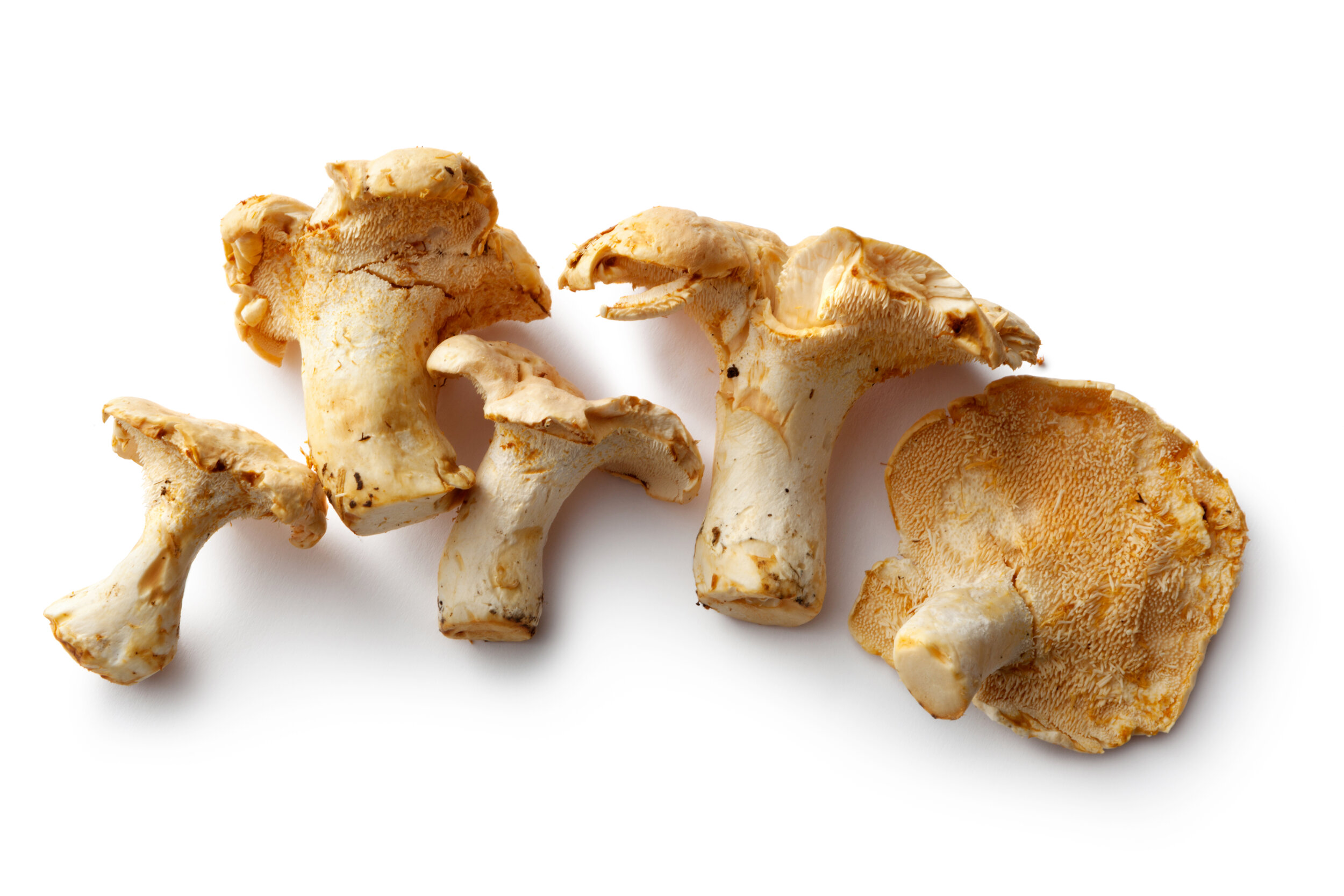For centuries, our ancestors have relied on the medicinal benefits of our forests' wild mushrooms. At Mountain Stream, we pride ourselves on our carefully harvested hand-picked wild mushrooms. Our skilled and knowledgeable mushroom hunters can bring fresh-picked mushrooms to market as quickly as possible to ensure freshness and the highest quality of forest-grown mushrooms.
Scientific Name: Morchella Conica.
Morel Mushrooms
Also known as: Pine Cone, Dryland Fish, Hickory Chicken.
Description: Honeycomb-like pattern in that the upper portion is composed of a network of ridges with pits between them. Pine-cone shaped. Prized by gourmet cooks, morels are hunted by thousands of people every year for profit and personal enjoyment.
Origin: Grows wild in Canada, Washington, Oregon, & California. They flourish in forested areas that were burned by a forest fire the year prior.
Uses: Very versatile mushroom, tasty addition to cream sauces, excellent stuffed.
Season: Fresh February-July.
Source: Hand-picked from local Pacific Northwest forests.
Shelf Life: 7 days (keep refrigerated).
Scientific Name: Boletus Edulis.
PORCINI MUSHROOM
Scientific Name: Boletus Edulis.
Also known as: King Bolete, Capes, Penny Bun.
Description: One of the most beautiful wild mushrooms available. Its robust flavor and texture make the Porcini one of the most popular mushrooms of chefs and restaurant patrons alike.
Origin: Grows wild in Oregon and Washington on the east side of the Cascades and Blue Mountain ranges.
Uses: Known for its legendary aroma, Porcini is often used in oils, powders, broths, soups, sauces, stir-fired and sautés.
Season: Local April-June.
Source: Hand-picked from local Pacific Northwest forests.
Scientific Name: Cantharellus formosus, C. cascadensis, C. cibarius var roseocanus.
Chanterelle MUSHROOM
Also known as: Golden Chanterelle, Queen of the Woods.
Description: Often referred to as one of the most distinctive flavored mushrooms in the world, chanterelles are native to the Northwest. Carefully hand-picked under Douglas Fir and Western Hemlock trees, Chanterelles are easily one of the most favored mushrooms worldwide.
Origin: Grows wild in Oregon and Washington from the coastal ranges to the Cascades.
Uses: Delicious on steak and chicken, stir-fry, or as a simple sauté.
Season: Fresh August-December.
Source: Hand-picked from local Pacific Northwest forests.
Shelf Life: 7-10 days (keep refrigerated).
Scientific Name: Hypomyces Lactifluorum growing on Russula brevipes.
Lobster Mushroom
Description: Lobster mushrooms get their name from their color similar to cooked lobster meat or lobster shell, as well as their seafood-like aroma. All of which makes it a great seafood substitute.
Origin: Grows wild in Oregon and Washington from the coastal ranges to the Cascades.
Uses: Best used in soups, stews, sautés or as a seafood substitute.
Season: Local June-October.
Source: Hand-picked from local Pacific Northwest forests.
Shelf Life: 7 days (keep refrigerated).
Scientific Name: Ticholoma Magnivelare.
MATSUTAKE MUSHROOM
Also known as: Pine or Ponderosa.
Description: This dense white or meaty brown delight has a thick cotton-like partial veil. The surface is smooth and dry, the stem short and broad. With age, the cap and stem develop rusty stains where bruised. But it is the odor that identifies this mushroom. It is very spicy and clean, like no other food.
Origin: Grows wild most abundantly along coastal regions especially in Oregon and Washington.
Uses: Flavor blends well with chicken, fish, and rice.
Season: Local September-December.
Source: Hand-picked from local Pacific Northwest forests.
Shelf Life: 7 days (keep refrigerated)
Scientific Name: Hydnum Repandum, H. umbilicatum.
Hedgehog Mushroom
Also known as: Sweet Tooth.
Description: The Hedgehog Mushroom cap is dry, yellow to light orange to brown. Often develops an irregular shape, especially when it has grown closely crowded with adjacent fruit bodies. The mushroom tissue is white with a pleasant odor and a spicy or bitter taste.
Origin: Grows in Pacific Forests of Washington, Oregon & California.
Uses: Simmer in milk or stock, or sauté. It creates a tender, meaty texture and mild flavor.
Season: Local November-March.
Source: Hand-picked from local Pacific Northwest forests.
Shelf Life: 7 days (keep refrigerated).
Scientific Name: Craterellus Tubaeformis.
YellowFoot Chanterelle Mushroom
Also known as: Winter Mushroom, Funnel Chanterelle.
Description: Yellowfoot Chanterelle mushrooms are small, fragile, and brightly colored with a signature golden yellow stem. They have a delicate flavor, somewhat like a mild golden chanterelle.
Origin: Grows wild in Oregon and Washington from the coastal ranges to the Cascades.
Uses: Delicious atop steak and chicken, stir-fry, or as a simple sauté.
Season: Local December-March.
Source: Hand-picked from local Pacific Northwest forests.
Shelf Life: 7 days (keep refrigerated).
Scientific Name: Craterellus cornucopioides.
Black Trumpet Mushroom
Also known as: Horn of Plenty.
Description: Black Trumpets have a rich, smoky flavor that is far better experienced than described. Their deep flavor works well in many recipes. A great addition to soups, sauces, pasta dishes, seafood recipes, or meals with any meat.
Origin: Grows wild in Southern Oregon and Northern California.
Uses: Black Trumpets pair well with many dishes, including sauces, pasta, and any meat dishes.
Season: Local December-March.
Source: Hand-picked from local Pacific Northwest forests.
Shelf Life: 7 days (keep refrigerated).





















